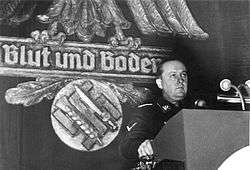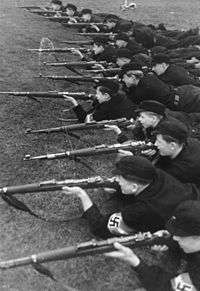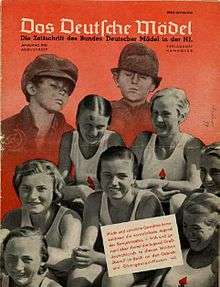Volksgemeinschaft
Volksgemeinschaft (German pronunciation: [ˈfɔlksɡəˌmaɪnʃaft]) is a German expression meaning "people's community".[1] This expression originally became popular during World War I as Germans rallied in support of the war, and it appealed to the idea of breaking down elitism and uniting people across class divides to achieve a national purpose.[2]
Development
The concept is believed to have originated in Ferdinand Tönnies' theory in his work Gemeinschaft und Gesellschaft ("Community and Society") of 1887.[3] Decades later, in 1932, Tönnies joined the Social Democratic Party of Germany to oppose the rise of Nazism and protest against their use of his concept. He had his honorary professorship removed when Adolf Hitler came to power.[4] In 1914, the Emperor Wilhelm II proclaimed before the Reichstag the Burgfrieden ("the peace within a castle under siege"), announcing that henceforward all of the regional differences between the different states of the Reich; between rich, middle class and poor; between Roman Catholics and Protestants; and between rural and urban no longer existed and the German people were all one for the duration of the war. During the war, many Germans longed to have the sense of unity that the Burgfrieden inspired continue after the war, and it was during this period that many ideas started to circulate about how to convert the wartime Burgfrieden into a peacetime volksgemeinschaft.
In the aftermath of World War I, the idea of Volksgemeinschaft was used to interpret economic catastrophes and hardship facing Germans during the Weimar Republic era as a common experience of the German nation and to argue for German unity to bring about renewal to end the crisis.[2] It was adopted by the Nazi Party to justify actions against Jews, profiteers, Marxists, and the Allies of World War I, whom the Nazis accused of obstructing German national regeneration, causing national disintegration in 1918 and Germany's defeat in World War I.[2]
There is an ongoing debate among historians as to whether a Volksgemeinschaft was or was not successfully established between 1933 and 1945. This is a notably controversial topic of debate for ethical and political reasons, and is made difficult by the ambiguous language employed by Hitler and the Nazis when talking about the Volksgemeinschaft.
Nazi Volksgemeinschaft
In the aftermath of the November Revolution of 1918 that marked the end of the German Empire and the beginning of the Weimar Republic, there was strong animosity amongst many Germans towards the Weimar Republic and the social democrats who sponsored its creation.[2] This was combined with anxiety in the 1930s with the severe economic crisis in Germany and abroad, in which many Germans faced unemployment.[2] This situation resulted in increasing popularity for the Nazi Party, including amongst workers who desired a government that would resolve the economic crisis.[5] While ascending to power, Hitler promised to restore faith in the Volk and to bring wholeness while accusing other politicians of tearing at German unity.[6]

Upon rising to power in 1933, the Nazis sought to gain support of various elements of society. Their concept of Volksgemeinschaft was racially unified and organized hierarchically.[7] This involved a mystical unity, a form of racial soul uniting all Germans.[8] This soul was regarded as related to the land, in the doctrine of "blood and soil".[8] Indeed, one reason for "blood and soil" was the belief that landowner and peasant lived in an organic harmony.[9] Germans who had sexual relations with non-Aryans were excluded from the people's community.[10]
The Nazis solidified support amongst nationalists and conservatives by presenting themselves as allied with President Paul von Hindenburg who was considered a war hero of World War I in Germany.[11] The Nazis sought to gain support of workers by declaring May Day, a day celebrated by organized labour, to be a paid holiday and held celebrations on 1 May 1933 to honour German workers.[12] The Nazis stressed that Germany must honour its workers.[13] The regime believed that the only way to avoid a repeat of the disaster of 1918 was to secure workers' support for the German government.[12] The regime also insisted through propaganda that all Germans take part in the May Day celebrations in the hope that this would help break down class hostility between workers and burghers.[13] Songs in praise of labour and workers were played by state radio throughout May Day as well as an airshow in Berlin and fireworks.[13] Hitler spoke of workers as patriots who had built Germany's industrial strength and had honourably served in the war and claimed that they had been oppressed under economic liberalism.[14] Berliner Morgenpost that had been strongly associated with the political left in the past praised the regime's May Day celebrations.[14]
Bonfires were made of school children's differently colored caps as symbolic of the abolition of class differences.[15]
The Nazis continued social welfare policies initiated by the governments of the Weimar Republic and mobilized volunteers to assist those impoverished, "racially-worthy" Germans through the National Socialist People's Welfare organization.[16] This organization oversaw charitable activities, and became the largest civic organization in Nazi Germany.[16] Successful efforts were made to get middle-class women involved in social work assisting large families.[15] The Winter Relief campaigns acted as a ritual to generate public feeling.[17]
In propaganda
Nazis gave a great deal of prominence to this new "folk community" in their propaganda, depicting the events of 1933 as a Volkwerdung, or a people becoming itself.[18] The Volk were not just a people; a mystical soul united them, and propaganda continually portrayed individuals as part of a great whole, worth dying for.[8] A common Nazi mantra declared they must put "collective need ahead of individual greed"—a widespread sentiment in this era.[19] To exemplify and encourage such views, when the Hitlerjugend and Bund Deutscher Mädel collected for Winterhilfswerk or Winter Relief, totals were not reported for any individuals, only what the branch raised.[17] The Winterhilfswerk campaigns themselves acted as a ritual to generate public feeling.[17]
Hitler declared that he knew nothing of bourgeois or proletarian, only Germans.[20] Volksgemeinschaft was portrayed as overcoming distinctions of party and social class.[21] The commonality this created across classes was among the great appeals of Nazism.[22]
After the failure of the Beer Hall Putsch, Hitler, on the trial, omitted his usual pre-putsch anti-Semitism and centered his defense on his selfless devotion to the good of the Volk and the need for bold action to save them.[23] The Versailles settlement had betrayed Germany, which they had tried to save.[24] Thereafter, his speeches concentrated on his boundless devotion to the Volk, though not entirely eliminating the anti-Semitism.[25] Even once in power, his immediate speeches spoke of serving Germany.[26] While the Reichstag fire was used to justify anti-Communist and anti-Semitic violence, Hitler himself spoke on a new life, honor, and unity in Germany.[27] Similarly, the Night of the Long Knives was justified as a peril to the people so great that only decisive action would save them.[28] Goebbels described Hitler after that event as suffering "tragic loneliness" and as a Siegfried forced to shed blood to preserve Germany.[29]
Devotion to this Volk is common in Nazi propaganda. An account, for instance, of a SA brawl depicted its leader as uncouth and therefore a simple, strong, and honest man of the people.[30] Sturmabteilung speakers were used, in part, for the appeal of their folksy manner.[31] One element of Horst Wessel's life that was fictionalized out of the movie Hans Westmar was the willfully provoking of violent conflicts with Communists; Westmar preaches class reconciliation, and his death unifies students and workers.[32] This changes was also propagandized to the Sturmabteilung, whose violent, rebellious and confrontational past had to be transformed to community organization to be useful in a Germany where Nazis held official power.[33]
This unity was what justified Nazi propaganda; its pejorative connotation had sprung solely from its selfish use, and the Nazis' honorable goal, the unity of the German people, made it honorable for them.[34]
It also justified the one-party state as all that was needed in a society with a united will, where Hitler implemented the will of the Volk more directly than in a democracy.[35] Attacks on Great Britain as a plutocracy also emphasized how the German, being able to participate in his Volk, is freer than the Briton.[36]
In his pamphlet State, Volk and Movement, Carl Schmitt praised the expulsion of Jews from political life without ever using the term "Jew" and using "non-Aryan" only rarely, by praising the homogeneity of the people and the Volksgemeinschaft ensuing; merely Gleichschaltung was not sufficient, but Nazi principles must continue to make the German people pure.[37]
Even Carl Jung's "collective unconscious" was preferred to Freudian concepts because of its communal element.[38]
The Volksgemeinschaft was also depicted in films on the home-front during World War II, with the war uniting all levels of society, as in the two most popular films of the Nazi era, Die grosse Liebe and Wunschkonzert.[39] The Request Concert radio show, on which the latter film was based, achieved great popularity by broadcasting music claimed to be requested by men in the armed forces.[40] Attempts to get women of "better classes" to take factory jobs were presented as breaking down class barriers and so helping create a true people's community.[41] Failure to support the war was an anti-social act; this propaganda managed to bring arms production to a peak in 1944.[42]
Community Aliens and National Comrades
National Socialist legal theory divided all Germans into two categories, namely the Volksgenossen ("National Comrades") who belonged to the Volksgemeinschaft and the Gemeinschaftsfremde ("Community Aliens") who did not. In addition to the duties and responsibilities shared by those in the community, the National Comrades were expected to build and create a "Volksgeist" that would encompass the best aspects of the German people. As such, community aliens could not belong, since they were deemed an undermining element in the very foundations of the "Volksgemeinschaft".
The modern German historian Detlev Peukert wrote the purpose of National Socialist social policy as:
“ The goal was an utopian Volksgemeinschaft, totally under police surveillance, in which any attempt at nonconformist behaviour, or even any hint or intention of such behaviour, would be visited with terror”.[43]
Criminals, if deemed unable to be part of the people's community, were severely punished, even executed for crimes that did not provide for the death penalty, such as doubling the sentence the prosecution asked for when a defendant had not helped put out a fire, thus showing a disregard for the life of his “Volksgenossen" and community.[44] In support of this, Peukert quoted two articles from the projected “Law for the Treatment of Community Aliens” of 1944, which though never implemented owing to bureaucratic quarrels showed the intentions of Nazi social policy:
"...Article I.Community Aliens (Gemeinschaftsfremde)
1.
"Community Aliens" are such persons who:
1, Show themselves, in their personality or in the conduct of their life, and especially in light of any unusual deficiency of mind or character, unable to comply by their own efforts with the minimum requirements of the national community.
2.(a) owning to work-shyness or slovenliness, lead a worthless, unthrifty or disorderly life and are thereby a burden or danger to the community:
Or
Display a habit of, or inclination towards beggary or vagrancy, idling at work, larceny, swindling or other less seriously offences, or engage in excessive drunkenness, or for any such reasons are in breach of their obligation to support themselves.
Or
(b) through persistent ill-temper or quarrelsomeness disturb the peace of the community;
3. show themselves, in their personality or the conduct of their life, mentally disposed towards the commission of serious offences (community-hostile criminals [gemeinschaftsfeindliche Verbrecher]) and criminals by inclination [Neigungsverbrecher]).
Article II
Police Measures Against Community Aliens
2.
1. Community aliens should be subject towards police supervision.
2. If supervisory measures are insufficient, the police shall transfer the community aliens to the Gau (or Land) welfare authorities.
3. If, in the case of any community alien persons, a stricter degree of custody is required than is possible within the institutions of the Gau (or Land) welfare authorities, the police shall place them in a police camp."[45]
Children and youth


In their desire to establish a total state, the Nazis understood the importance of “selling” their ideology to the youth. To accomplish this, Hitler established Nazi youth groups. Young boys from 6–10 years old participated in the Pimpfen, similar to the cub scouts. Boys from 10–14 years old participated in the Deutsches Jungvolk, and boys 14–18 years old participated in the Hitler Jugend (Hitler Youth).[47] The two older groups fostered military values and virtues, such as duty, obedience, honor, courage, strength, and ruthlessness. Uniforms and regular military drills were supplemented by ceremonies honoring the war dead. Most importantly, the Hitler Youth did their utmost to indoctrinate the youth of Germany with the ideological values of Nazism. Youth leaders bore into the youth a sense of fervent patriotism and utter devotion to Hitler, including military training so as to be ready to join the Wehrmacht. By 1939, when membership in the Hitler Youth became compulsory, each new member of the Jungvolk was required to take an oath to the Führer swearing total allegiance.
Young girls were also a part of the Hitler Youth in Nazi Germany. Girls from 10–14 years old were members of the Jungmädelbund, while girls fourteen to eighteen belonged to the Bund Deutscher Mädel.[47] Hitler youth girls were indoctrinated in the principles of service, regimentation, obedience, and discipline. Girls were taught to be dutiful wives and mothers. Members of the Bund Deutscher Mädel were educated in the skills needed for domestic chores, nursing, and hygiene.
Daily life in Nazi Germany was manipulated from the beginning of Nazi rule. Propaganda dominated popular culture and entertainment. Anti-intellectualism was used to prevent the people from thinking and feeding into their strong sense of national and military pride. Finally, Hitler and the party realized the possibilities of controlling Germany’s youth as a means of continuing the Reich as they wanted the generation of Germans to follow to be dedicated to the strengthening and preservation of the German Volk and of the "Greater German Reich".
See also
References
- ↑ Peter Fritzsche. Life and Death in the Third Reich. President and Fellows of Harvard College, 2008. p. 38.
- 1 2 3 4 5 Fritzsche, p. 39.
- ↑ Francis Ludwig Carsten, Hermann Graml. The German resistance to Hitler. Berkeley and Los Angeles, California, USA: University of California Press. p. 93
- ↑ Ferdinand Tönnies, José Harris. Community and civil society. Cambridge University Press, 2001 (first edition in 1887 as Gemeinschaft und Gesellschaft). Pp. xxxii-xxxiii.
- ↑ Fritzsche. p. 41.
- ↑ Claudia Koonz, The Nazi Conscience, p 18 ISBN 0-674-01172-4
- ↑ fascism. (2010). In Encyclopædia Britannica. Retrieved December 15, 2010, from Encyclopædia Britannica Online: http://www.britannica.com/EBchecked/topic/202210/fascism
- 1 2 3 "The Volk"
- ↑ Robert Cecil, The Myth of the Master Race: Alfred Rosenberg and Nazi Ideology p166 ISBN 0-396-06577-5
- ↑ Diemut Majer, Non-Germans Under The Third Reich, p.369
- ↑ Fritzsche, p. 44-45.
- 1 2 Fritzsche, p.45.
- 1 2 3 Fritzsche, p. 46.
- 1 2 Fritzsche, p. 47.
- 1 2 Richard Grunberger, The 12-Year Reich, p 46, ISBN 0-03-076435-1
- 1 2 Fritzsche, p. 51.
- 1 2 3 Richard Grunberger, The 12-Year Reich, p 79, ISBN 0-03-076435-1
- ↑ Richard Grunberger, The 12-Year Reich, p 18, ISBN 0-03-076435-1
- ↑ Claudia Koonz, The Nazi Conscience, p 6 ISBN 0-674-01172-4
- ↑ Richard Overy, The Dictators: Hitler's Germany, Stalin's Russia, p232 ISBN 0-393-02030-4
- ↑ Richard Grunberger, The 12-Year Reich, p 19, ISBN 0-03-076435-1
- ↑ Milton Mayer, They Thought They Were Free: The Germans 1933-45 p105 1995 University of Chicago Press Chicago
- ↑ Claudia Koonz, The Nazi Conscience, p 21 ISBN 0-674-01172-4
- ↑ Richard Overy, The Dictators: Hitler's Germany, Stalin's Russia, p3 ISBN 0-393-02030-4
- ↑ Claudia Koonz, The Nazi Conscience, p 25 ISBN 0-674-01172-4
- ↑ Claudia Koonz, The Nazi Conscience, p 31 ISBN 0-674-01172-4
- ↑ Claudia Koonz, The Nazi Conscience, p 40 ISBN 0-674-01172-4
- ↑ Claudia Koonz, The Nazi Conscience, p 96 ISBN 0-674-01172-4
- ↑ Anthony Rhodes, Propaganda: The art of persuasion: World War II, p16 1976, Chelsea House Publishers, New York
- ↑ George Lachmann Mosse, Nazi culture: intellectual, cultural and social life in the Third Reich p 18 ISBN 978-0-299-19304-1
- ↑ Claudia Koonz, The Nazi Conscience, p 89 ISBN 0-674-01172-4
- ↑ Claudia Koonz, The Nazi Conscience, p. 85-6 ISBN 978-0-674-01172-4
- ↑ Claudia Koonz, The Nazi Conscience, p. 86-8 ISBN 978-0-674-01172-4
- ↑ Leila J. Rupp, Mobilizing Women for War, p 99-100, ISBN 978-0-691-60013-0
- ↑ Richard Overy, The Dictators: Hitler's Germany, Stalin's Russia, p58-9 ISBN 0-393-02030-4
- ↑ Michael Balfour, Propaganda in War 1939-1945: Organisation, Policies and Publics in Britain and Germany, p163 ISBN 0-7100-0193-2
- ↑ Claudia Koonz, The Nazi Conscience, p 59-60 ISBN 0-674-01172-4
- ↑ George Lachmann Mosse, Nazi culture: intellectual, cultural and social life in the Third Reich p 199 ISBN 978-0-299-19304-1
- ↑ Erwin Leiser, Nazi Cinema p63 ISBN 0-02-570230-0
- ↑ Robert Edwin Hertzstein, The War That Hitler Won p294-5 ISBN 0-399-11845-4
- ↑ Leila J. Rupp, Mobilizing Women for War, p 131, ISBN 0-691-04649-2, OCLC 3379930
- ↑ Michael Balfour, Propaganda in War 1939-1945: Organisation, Policies and Publics in Britain and Germany, p373 ISBN 0-7100-0193-2
- ↑ Peukert, Detlev Inside Nazi Germany: Conformity, Opposition and Racism In Everyday Life, London : Batsford, 1987 page 220.
- ↑ Richard Grunberger, The 12-Year Reich, p 122-3, ISBN 0-03-076435-1
- ↑ Peukert, Detlev Inside Nazi Germany: Conformity, Opposition and Racism In Everyday Life, London : Batsford, 1987 page 221.
- ↑ "German Propaganda Archive: The German Girl". Calvin College. Retrieved 21 September 2012.
- 1 2 Walter S. Zapotoczny, "Rulers of the World: The Hitler Youth"
